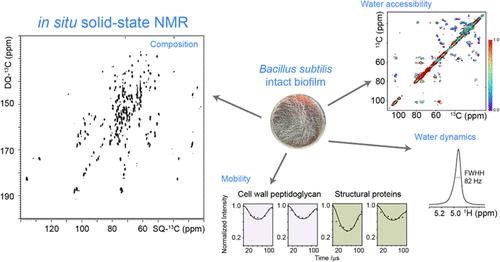当前位置:
X-MOL 学术
›
J. Am. Chem. Soc.
›
论文详情
Our official English website, www.x-mol.net, welcomes your feedback! (Note: you will need to create a separate account there.)
Uncovering the Molecular Composition and Architecture of the Bacillus subtilis Biofilm via Solid-State NMR Spectroscopy
Journal of the American Chemical Society ( IF 15.0 ) Pub Date : 2024-04-17 , DOI: 10.1021/jacs.4c00889 Yi Xue 1 , Chenjie Yu 1 , Han Ouyang 1 , Jiaofang Huang 2 , Xue Kang 1
Journal of the American Chemical Society ( IF 15.0 ) Pub Date : 2024-04-17 , DOI: 10.1021/jacs.4c00889 Yi Xue 1 , Chenjie Yu 1 , Han Ouyang 1 , Jiaofang Huang 2 , Xue Kang 1
Affiliation

|
The complex and dynamic compositions of biofilms, along with their sophisticated structural assembly mechanisms, endow them with exceptional capabilities to thrive in diverse conditions that are typically unfavorable for individual cells. Characterizing biofilms in their native state is significantly challenging due to their intrinsic complexities and the limited availability of noninvasive techniques. Here, we utilized solid-state nuclear magnetic resonance (NMR) spectroscopy to analyze Bacillus subtilis biofilms in-depth. Our data uncover a dynamically distinct organization within the biofilm: a dominant, hydrophilic, and mobile framework interspersed with minor, rigid cores of limited water accessibility. In these heterogeneous rigid cores, the major components are largely self-assembled. TasA fibers, the most robust elements, further provide a degree of mechanical support for the cell aggregates and some lipid vesicles. Notably, rigid cell aggregates can persist even without the major extracellular polymeric substance (EPS) polymers, although this leads to slight variations in their rigidity and water accessibility. Exopolysaccharides are exclusively present in the mobile domain, playing a pivotal role in its water retention property. Specifically, all water molecules are tightly bound within the biofilm matrix. These findings reveal a dual-layered defensive strategy within the biofilm: a diffusion barrier through limited water mobility in the mobile phase and a physical barrier posed by limited water accessibility in the rigid phase. Complementing these discoveries, our comprehensive, in situ compositional analysis is not only essential for delineating the sophisticated biofilm architecture but also reveals the presence of alternative genetic mechanisms for synthesizing exopolysaccharides beyond the known pathway.
中文翻译:

通过固态核磁共振波谱揭示枯草芽孢杆菌生物膜的分子组成和结构
生物膜复杂而动态的组成,及其复杂的结构组装机制,赋予它们在通常不利于单个细胞的各种条件下茁壮成长的卓越能力。由于生物膜内在的复杂性和非侵入性技术的可用性有限,表征其天然状态的生物膜具有很大的挑战性。在这里,我们利用固态核磁共振(NMR)光谱来深入分析枯草芽孢杆菌生物膜。我们的数据揭示了生物膜内动态独特的组织:一个占主导地位的、亲水的、可移动的框架,散布着有限的水可及性的较小的、刚性的核心。在这些异构刚性核心中,主要部件大部分是自组装的。 TasA 纤维是最坚固的元素,进一步为细胞聚集体和一些脂质囊泡提供一定程度的机械支撑。值得注意的是,即使没有主要的细胞外聚合物(EPS)聚合物,刚性细胞聚集体也可以持续存在,尽管这会导致其刚性和水可及性略有变化。胞外多糖仅存在于移动域中,在其保水性能中发挥着关键作用。具体来说,所有水分子都紧密结合在生物膜基质内。这些发现揭示了生物膜内的双层防御策略:流动相中有限的水流动性形成的扩散屏障和刚性相中有限的水可及性形成的物理屏障。作为对这些发现的补充,我们全面的原位成分分析不仅对于描绘复杂的生物膜结构至关重要,而且还揭示了在已知途径之外合成胞外多糖的替代遗传机制的存在。
更新日期:2024-04-17
中文翻译:

通过固态核磁共振波谱揭示枯草芽孢杆菌生物膜的分子组成和结构
生物膜复杂而动态的组成,及其复杂的结构组装机制,赋予它们在通常不利于单个细胞的各种条件下茁壮成长的卓越能力。由于生物膜内在的复杂性和非侵入性技术的可用性有限,表征其天然状态的生物膜具有很大的挑战性。在这里,我们利用固态核磁共振(NMR)光谱来深入分析枯草芽孢杆菌生物膜。我们的数据揭示了生物膜内动态独特的组织:一个占主导地位的、亲水的、可移动的框架,散布着有限的水可及性的较小的、刚性的核心。在这些异构刚性核心中,主要部件大部分是自组装的。 TasA 纤维是最坚固的元素,进一步为细胞聚集体和一些脂质囊泡提供一定程度的机械支撑。值得注意的是,即使没有主要的细胞外聚合物(EPS)聚合物,刚性细胞聚集体也可以持续存在,尽管这会导致其刚性和水可及性略有变化。胞外多糖仅存在于移动域中,在其保水性能中发挥着关键作用。具体来说,所有水分子都紧密结合在生物膜基质内。这些发现揭示了生物膜内的双层防御策略:流动相中有限的水流动性形成的扩散屏障和刚性相中有限的水可及性形成的物理屏障。作为对这些发现的补充,我们全面的原位成分分析不仅对于描绘复杂的生物膜结构至关重要,而且还揭示了在已知途径之外合成胞外多糖的替代遗传机制的存在。



























 京公网安备 11010802027423号
京公网安备 11010802027423号